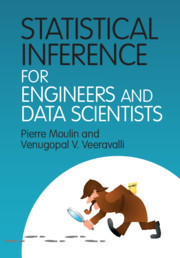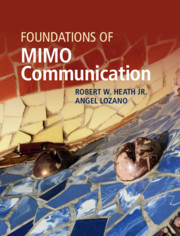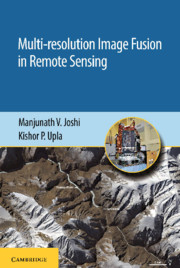Refine listing
Actions for selected content:
9096 results in Communications, Signal Processing and Information Theory
List of Symbols
-
- Book:
- Lightwave Communications
- Published online:
- 20 March 2019
- Print publication:
- 10 January 2019, pp xxviii-xxxviii
-
- Chapter
- Export citation

Statistical Inference for Engineers and Data Scientists
-
- Published online:
- 12 December 2018
- Print publication:
- 22 November 2018
-
- Textbook
- Export citation

Foundations of MIMO Communication
-
- Published online:
- 10 December 2018
- Print publication:
- 06 December 2018

Multi-resolution Image Fusion in Remote Sensing
-
- Published online:
- 06 December 2018
- Print publication:
- 24 January 2019
2 - A signal processing perspective
- from Part I - Wireless Communication Theory
-
- Book:
- Foundations of MIMO Communication
- Published online:
- 10 December 2018
- Print publication:
- 06 December 2018, pp 57-130
-
- Chapter
- Export citation
Appendix C - Random variables and processes
- from Appendices
-
- Book:
- Foundations of MIMO Communication
- Published online:
- 10 December 2018
- Print publication:
- 06 December 2018, pp 661-673
-
- Chapter
- Export citation
9 - MU-MIMO with linear transceivers
- from Part III - Multiuser MIMO
-
- Book:
- Foundations of MIMO Communication
- Published online:
- 10 December 2018
- Print publication:
- 06 December 2018, pp 497-577
-
- Chapter
- Export citation
1 - A primer on information theory and MMSE estimation
- from Part I - Wireless Communication Theory
-
- Book:
- Foundations of MIMO Communication
- Published online:
- 10 December 2018
- Print publication:
- 06 December 2018, pp 3-56
-
- Chapter
-
- You have access
- Export citation
Index
-
- Book:
- Foundations of MIMO Communication
- Published online:
- 10 December 2018
- Print publication:
- 06 December 2018, pp 752-764
-
- Chapter
- Export citation
Appendices
-
- Book:
- Foundations of MIMO Communication
- Published online:
- 10 December 2018
- Print publication:
- 06 December 2018, pp 647-648
-
- Chapter
- Export citation
Appendix E - Special functions
- from Appendices
-
- Book:
- Foundations of MIMO Communication
- Published online:
- 10 December 2018
- Print publication:
- 06 December 2018, pp 676-679
-
- Chapter
- Export citation
Part III - Multiuser MIMO
-
- Book:
- Foundations of MIMO Communication
- Published online:
- 10 December 2018
- Print publication:
- 06 December 2018, pp 413-414
-
- Chapter
- Export citation
8 - MU-MIMO with optimum transceivers
- from Part III - Multiuser MIMO
-
- Book:
- Foundations of MIMO Communication
- Published online:
- 10 December 2018
- Print publication:
- 06 December 2018, pp 436-496
-
- Chapter
- Export citation
5 - SU-MIMO with optimum receivers
- from Part II - Single-user MIMO
-
- Book:
- Foundations of MIMO Communication
- Published online:
- 10 December 2018
- Print publication:
- 06 December 2018, pp 297-385
-
- Chapter
- Export citation
11 - Afterword
- from Part III - Multiuser MIMO
-
- Book:
- Foundations of MIMO Communication
- Published online:
- 10 December 2018
- Print publication:
- 06 December 2018, pp 643-646
-
- Chapter
- Export citation
Appendix F - Landau symbols
- from Appendices
-
- Book:
- Foundations of MIMO Communication
- Published online:
- 10 December 2018
- Print publication:
- 06 December 2018, pp 680-680
-
- Chapter
- Export citation
Appendix A - Transforms
- from Appendices
-
- Book:
- Foundations of MIMO Communication
- Published online:
- 10 December 2018
- Print publication:
- 06 December 2018, pp 649-652
-
- Chapter
- Export citation
Preface
-
- Book:
- Foundations of MIMO Communication
- Published online:
- 10 December 2018
- Print publication:
- 06 December 2018, pp xv-xvi
-
- Chapter
- Export citation
3 - Channel modeling
- from Part I - Wireless Communication Theory
-
- Book:
- Foundations of MIMO Communication
- Published online:
- 10 December 2018
- Print publication:
- 06 December 2018, pp 131-208
-
- Chapter
- Export citation
Dedication
-
- Book:
- Foundations of MIMO Communication
- Published online:
- 10 December 2018
- Print publication:
- 06 December 2018, pp v-vi
-
- Chapter
- Export citation
